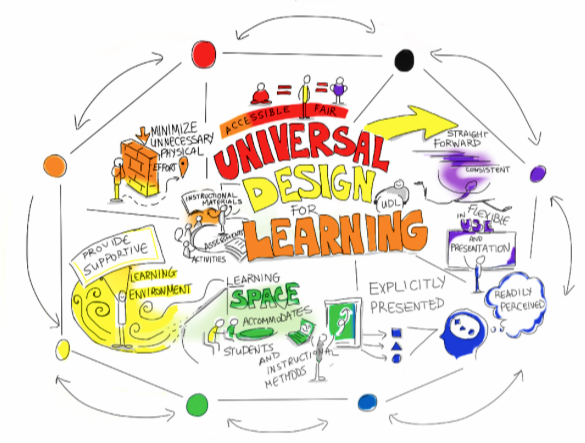I recently sat in a training focused on the need to increase access and equity in classrooms for students with visible and non-visible disabilities. While this is often a topic discussed among special education educators, it is important to highlight the fact that we all have students who are struggling for one reason or another. In 2017, the California Department of Education released data that showed 774,665 students ages 0-22 had been labeled with some form of disability through an IEP (Individualized Education Program). While this does not include students with 504 plans (which are “formal plans that schools develop to give kids with disabilities the support they need” but are different from IEPs),it already encompasses 11% of all students in CA. This means that on average, for every 10 students, at least one student is coming into our classrooms with a “labeled” disability; this does not mean that they are less capable.
The reality is students who can’t access curriculum are disabled from the get-go. This applies to all of our students. As teachers, we often discuss student’s capabilities in relation to their achievement in the classroom without truly recognizing that maybe students are not the problem. Maybe it’s the curriculum that is disabled. Going off the concept “when a flower doesn’t bloom, you fix the environment in which it grows, not the flower,” a framework was created that changes the way we teach students so that we can transform student’s learning environments to address their needs rather than continue to try and “fix” the student.
This is where Universal Design for Learning (UDL) stems from. In simplest terms, each part of “UDL” signifies a different element that must be incorporated to allow students to demonstrate what they are ABLE to do rather than simply be seen by their labels.
- Universal: Each and every learner — not just those traditionally seen as belonging in the middle of the bell curve. This requires educators to teach to the edges, encompassing students from all academic levels.
- Design: Intentional, purposeful and planned for learner variability. In the way that architects must design a building with a plan for handicap access, teachers must also design their learning environments with intent to be accessible for all students.
- Learning: All individuals are challenged and supported in meaningful ways to grow toward expertise as learners.
By integrating UDL into the way we plan for our students, we can make sure that students who have been marginalized (and that certainly means students with disabilities or students who don’t know the language as well as those underserved who are gifted and are bored with the curriculum) have an opportunity to succeed.
In essence, in order for us to be the best teachers we can be, our goal should always be to develop expert learners. To help build an understanding of how to do this in order to be better educators and advocates for our students, it is important to become familiar with the three guiding principles of UDL.
Principle #1: Provide multiple means of engagement: This principle touches on the WHY of learning. This principle needs to be embedded within every single lesson and every single test. Before students can learn, they must be engaged. This requires multiple options to enhance interest and foster collaboration and community. This is also a critical part of ensuring students are led to a pathway that will allow them to be purposeful and motivated learners.
Principle #2: Provide multiple means of Representation: This principle touches on the WHAT of learning. Learning requires more than concentration. Through multiple means of representation, teachers should provide different options for students to comprehend the material. This includes the use of manipulatives, building background knowledge and never assuming that students can recall what they have read. In providing students a variety of ways of accessing the information, we are developing resourceful, knowledgeable learners.
Principle #3: Provide multiple means of Action and Expression: This principle touches on the HOW of Learning. This requires educators to provide students options for expressing what they have learned through peer interactions and multiple options of presentation.
As we move toward a more equitable and accessible educational system for our students, it will be critical for us, as teachers, to be willing to increase the quality of our work in order to be inclusive of all students. We must be willing to adapt our teaching so that we stop thinking of instruction as different for students with disabilities and students in general education. We must allow for universal access to all of our students which simply requires that we are open to other ways of teaching than the traditional cookie-cutter method.
Alma Renteria
Latest posts by Alma Renteria (see all)
- Rincón Universitario: Cómo Escribir una Narrativa Auténtica para Solicitudes de Universidades, Parte 3 - October 17, 2019
- College Corner: How To Write An Authentic Narrative for College Applications, Part 3 - October 15, 2019
- Rincón Universitario: Cómo Escribir Una Narrativa Auténtica para Solicitudes Universitarias, Parte 2 - October 1, 2019
- College Corner: How To Write An Authentic Narrative for College Applications, Part 2 - September 26, 2019
- College Corner: Cómo Escribir un Relato Auténtico de Solicitudes para la Universidad, Parte 1 - September 4, 2019


Pingback: Universal Design for Learning – Taylor’s Web Portfolio
Pingback: Adjusting for Size: Universal Design for Learning – Welcome to Technology and Teaching!